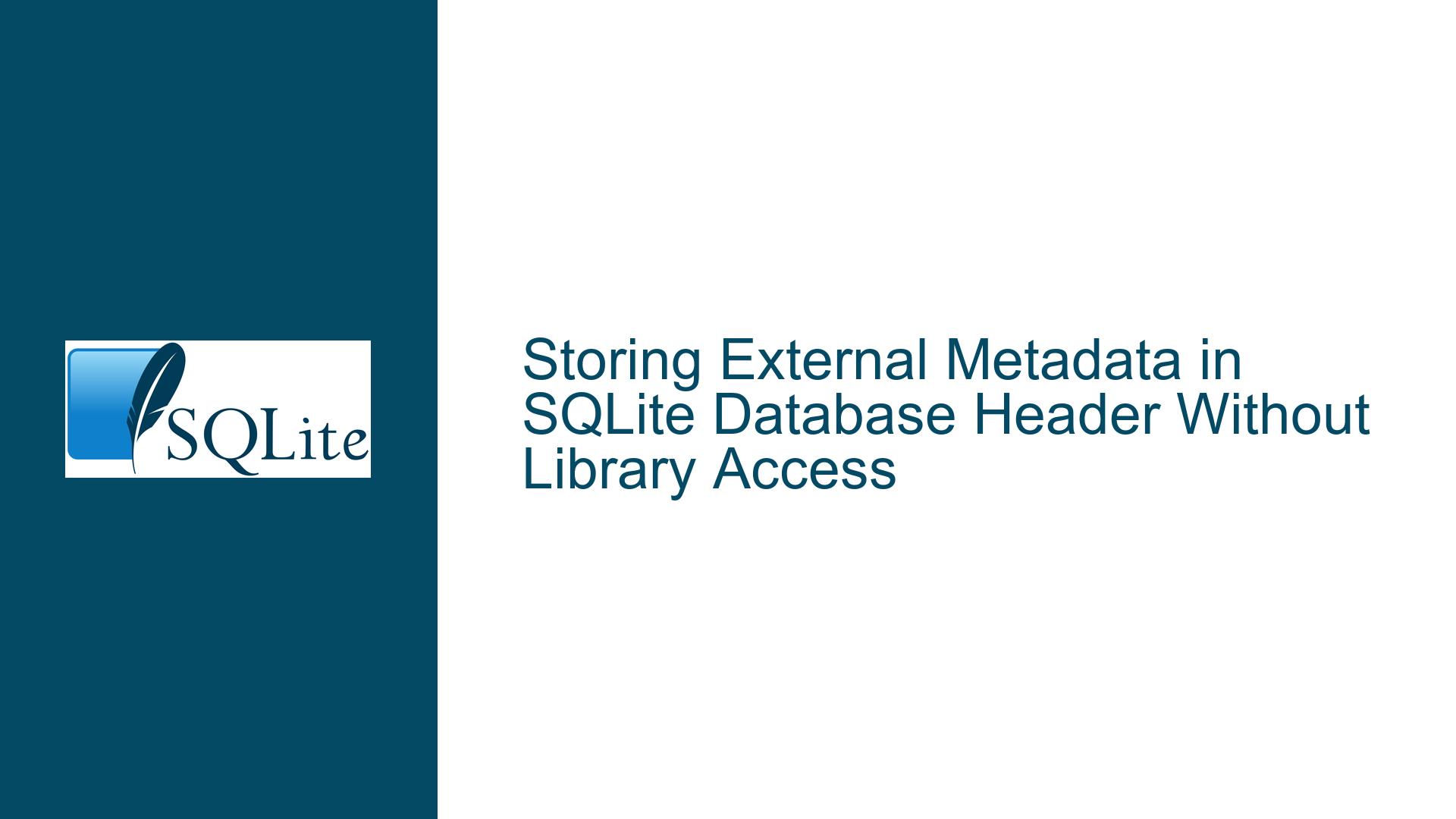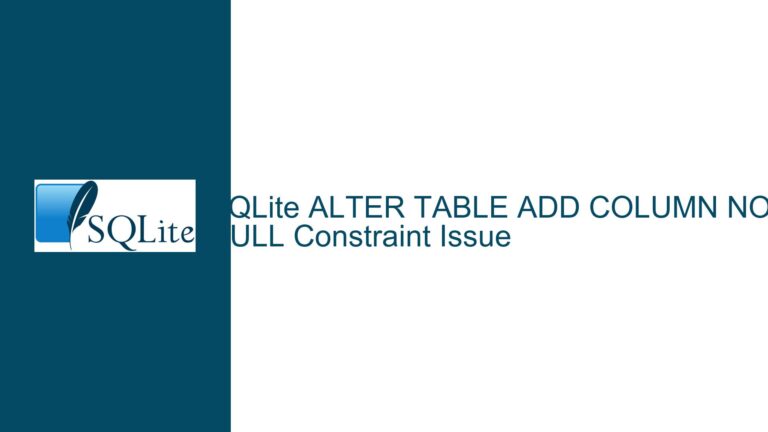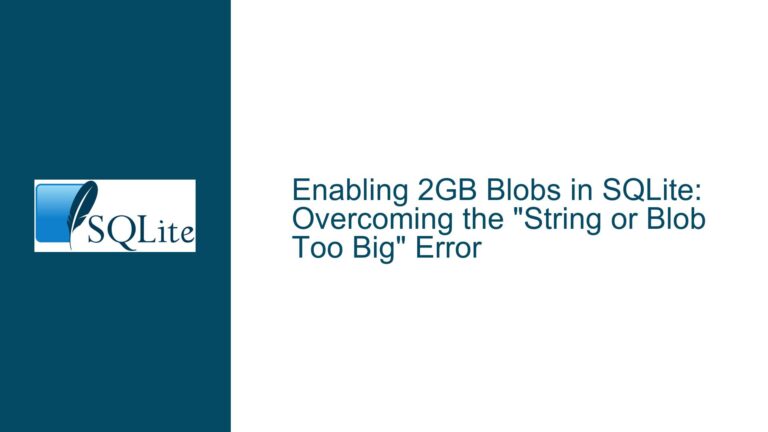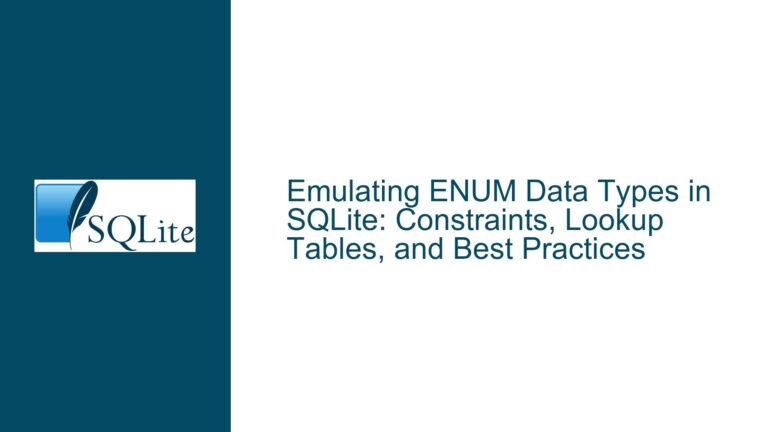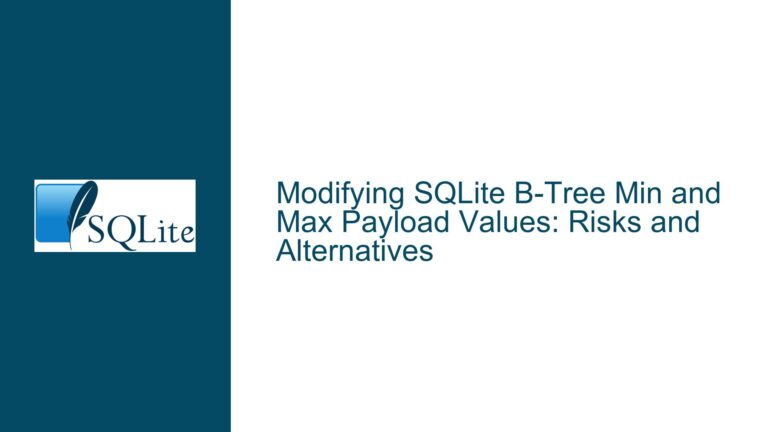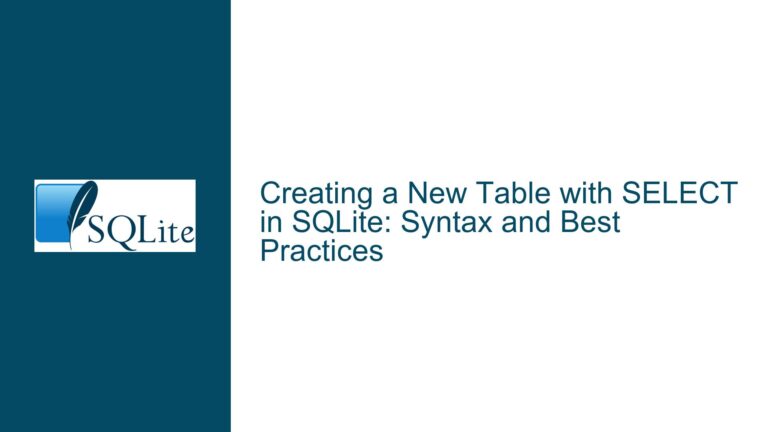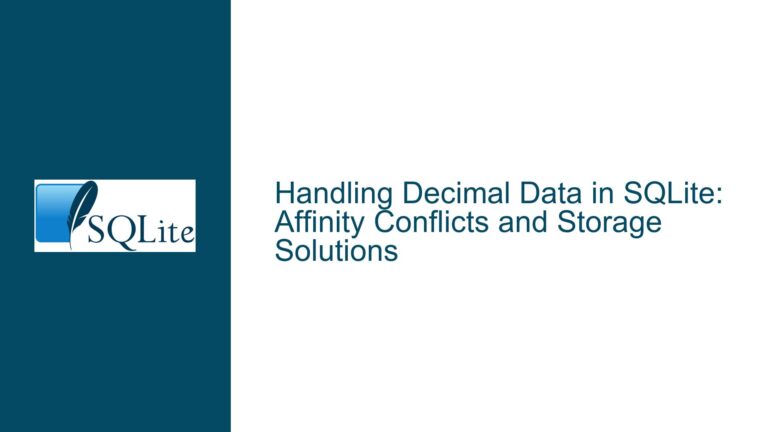Storing External Metadata in SQLite Database Header Without Library Access
Metadata Storage Requirements & SQLite File Structure Limitations
Issue Overview
The core challenge involves embedding custom metadata within SQLite database files for rapid access across thousands of files without invoking SQLite libraries. Direct file I/O operations are preferred to avoid the overhead of opening databases through standard APIs. The goal is to reserve a fixed offset (ideally within the first database page) where metadata can be read/written using basic file system operations while ensuring compatibility with Windows, iOS, and Android.
Key constraints include:
- Avoiding schema-based storage (e.g., dedicated metadata tables) due to performance degradation when opening numerous files
- Preserving database integrity despite external modifications
- Ensuring metadata persistence across SQLite operations like
VACUUMor schema changes - Preventing collisions with SQLite’s internal page management and locking mechanisms
The SQLite file format reserves 72 bytes at the start of the first page (bytes 28–99) for the "File Change Counter" and "Database Size in Pages" fields. Beyond these, the format allows reserving additional space via the SQLITE_DEFAULT_PAGE_SIZE and SQLITE_DEFAULT_RESERVE_SIZE compile-time options. However, the discussion reveals several undocumented or semi-supported methods to embed metadata, each with distinct tradeoffs.
Risks of Uncoordinated Page Modifications & Schema Design
Possible Causes
1. Unsafe Use of Reserved Page Space
SQLite allows reserving bytes at the end of each b-tree page via PRAGMA schema.page_size and PRAGMA schema.reserve_bytes. While this space is guaranteed not to be overwritten by SQLite, external writes to these regions risk corruption if:
- The reserved bytes setting changes after metadata is written
- Concurrent processes modify the same page without SQLite’s locking mechanisms
- Page boundaries shift due to
VACUUMorAUTO_VACUUMoperations
2. Schema-Based Metadata Encoding Vulnerabilities
Embedding metadata in schema objects (tables/views) relies on undocumented behavior:
- Schema entries are stored as plain text in the
sqlite_schematable, which resides on the first page. Overloading table/view definitions with metadata comments (e.g.,CREATE TABLE meta /*...*/) may work initially but fails if:- The schema exceeds the first page due to additional objects or larger page sizes
- SQLite reformats schema entries during
ALTERorVACUUMoperations - Database encoding changes (e.g., UTF-8 vs. UTF-16), altering byte offsets
3. File Size Manipulation Pitfalls
Artificially inflating the database file size (by updating the "Database Size in Pages" header field) creates unused space for metadata. This approach causes:
PRAGMA integrity_checkfailures ("Page N is never used")- Data loss during
VACUUMor backup operations, which truncate unused pages - Endianness errors when modifying the 4-byte "Database Size in Pages" field (stored as big-endian)
4. Concurrency & Locking Oversights
Direct file writes bypass SQLite’s transaction and locking protocols. Concurrent modifications by SQLite and external tools may result in:
- Partial writes due to interrupted file operations
- Journal file desynchronization (e.g., rollback journals or WAL files not reflecting metadata changes)
- Platform-specific file locking behavior (e.g., Windows mandatory locking vs. POSIX advisory locks)
Metadata Injection Techniques & Mitigation Strategies
Troubleshooting Steps, Solutions & Fixes
Method 1: Reserved Bytes at Page End
Implementation:
- Initialize databases with reserved space:
PRAGMA page_size = 4096; PRAGMA reserve_bytes = 128; -- Reserve 128 bytes per page - Write metadata to the last 128 bytes of the first page (offset
page_size - reserve_bytes). For a 4096-byte page, metadata starts at offset 3968.
Validation:
- Confirm reserve_bytes is consistent across all databases
- Use
PRAGMA schema_infoto detect page size changes - Checksum reserved regions to detect unintended SQLite overwrites
Platform-Specific Considerations:
- Windows: Use
LockFile/UnlockFileAPIs to coordinate access with SQLite processes - iOS/Android: Prefer
fcntl(F_WRLCK)for advisory locks, but assume SQLite may not honor external locks
Method 2: Schema Object Metadata Encoding
Implementation:
- Create a minimal schema object with metadata in its definition:
CREATE VIEW meta AS SELECT 1 /* Metadata: ABCDEF... */; - Locate the metadata string by scanning the first 4096 bytes for the
/* Metadata: ... */pattern.
Optimizations:
- Pad metadata to a fixed length (e.g., 256 bytes) for predictable offsets
- Use
PRAGMA schema.page_size = 65536to ensure the entire schema fits on the first page
Risks:
ALTER TABLEorVACUUMmay reformat schema entries, stripping comments- Database encryption (e.g., SQLCipher) obfuscates schema text
Method 3: AppendVFS for Isolated Metadata
Implementation:
- Compile SQLite with the appendvfs extension.
- Initialize databases with appended metadata:
ATTACH 'file:main.db?vfs=apndvfs' AS main; -- SQLite operations write to the base file - External tools append metadata to the end of the .db file, which appendvfs ignores.
Validation:
- Use
stat()to verify base file size remains constant during appends - Prepend metadata length and CRC32 checksum to detect truncation
Limitations:
- AppendVFS is not enabled by default on most platforms
- Third-party tools may misinterpret the appended data as corruption
Method 4: Header Field Abuse
Implementation:
- Repurpose the 20-byte "SQLite format 3\000" header string (bytes 0–15) by:
- Overwriting the zero-terminator (byte 15) and bytes 16–19 (page size) with metadata
- Adjusting page size to a non-standard value (e.g., 512) to free header space
- Revert to standard settings before SQLite access.
Validation:
- SQLite ignores header bytes 16–63 after initialization, but this is undocumented
- Test across SQLite versions 3.7.0+ for consistent behavior
Risks:
- SQLite may overwrite header fields during
VACUUMorPRAGMA page_sizechanges - Non-standard page sizes degrade performance
Concurrency Mitigation
- Cooperative Locking: Implement a global mutex (e.g., file locks) before metadata access
- Atomic Writes: On POSIX systems, use
pwrite()withO_DIRECTto avoid partial writes - Checksums: Embed CRC32 or SHA1 hashes to detect corruption from concurrent SQLite writes
Cross-Platform Testing
- Windows: Test with mandatory locking enabled (
DisableForceFlushregistry key) - iOS: Validate App Sandbox file access rules for direct I/O
- Android: Use
android.database.sqlitein "noop" mode to avoid Open/Close overhead
Fallback Strategy
- Maintain an external metadata cache (e.g., SQLite database of file paths and metadata)
- Use inotify/FSEvents to detect database changes and refresh the cache
- Periodically reconcile the cache with direct file reads to handle edge cases
This approach balances speed and reliability but introduces cache synchronization complexity.
By methodically addressing reserved space allocation, schema encoding stability, and concurrency hazards, developers can safely embed metadata within SQLite files while minimizing corruption risks. Direct header modifications remain inherently fragile but feasible under controlled conditions.
